![]() Capos with yoke and screw
Capos with yoke and screw
Capos of this type are first seen in the late 1700's. They are still going strong.
| OLDIES: |
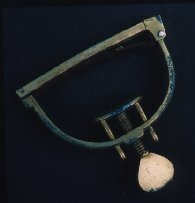 |
This capo is from around 1840. Leather pads on
the bar and protection plate, are fastened with rivets. [Owner: The Music Museum in Stockholm] |
| This is the oldest capo in my collection. Very similar to the capo above. Leather pads fastened with rivets. The pad on the plate is missing. | 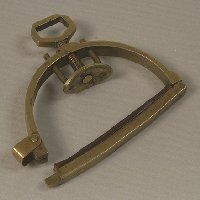 |
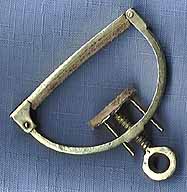 |
Capo from around 1900. Now the pads are glued to the capo. The leather
pads are not original. [Owner: Uwe Grefrath, Germany] |
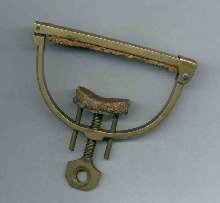 |
Another similar capo from around 1920. The cork
pads glued to the bar and plate are probably not original. [Donated by Ove Sundeson, Sweden.] |
 |
Here the yoke is less worked on. The intersection is square. [Owner: Keegan Day, Connecticut, USA.] |
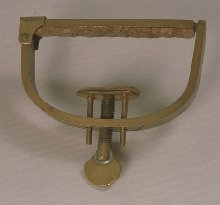 |
Unknown capo from the 1960's. Brass with cork padding. | |
| Compare it with the C-clamp from the same period. The screw arrangements are identical. | ||
| Banjocapo made in 1978 by Olle Larsson. Bronze. The yoke is made out of a ring. The screw and button is made in one piece. Pad and neck protection are made of cloth. The protection plate is not riveted to the screw. To keep it from falling out, the guide pins are slightly spread. [Donated by Olle Larsson,
Sweden.] |
| DEVELOPMENTS: | ||
| Hamilton Screw Type A variation from the 1950's. Easier manufacturing by making the bar turn sideways. Black rubber tubing. Made by Krauth & Benninghofen Co, USA.
|
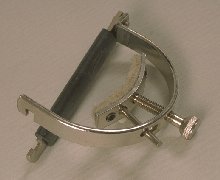   |
|
| The same yoke and bar is also used on a spring
action capo made by the same manufacturer. . |
||
| Another similar Hamilton type capo. Transparent plastic tubing and a flat screw head. | ||
| This one from the late sixties is marked ROLIF B&M. The broken rivet is replaced with a screw and the felt pad is modified. The rubber tubing seems to be original tough. | ||
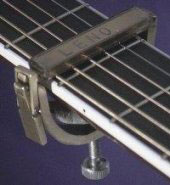 |
Leno |
|
|
||
| Leno started making a capo for resophonic guitars.
The production stopped in the mid 1990's for a couple of years. Now they are back again,
also making guitar and banjo capos. A trademark is the buckle to open and close the capo. Marketed by Leno Capo & Guitar Company. |
||
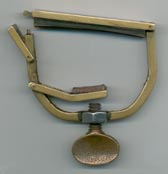  |
Here is an extreme capo. In order to preserve tone and
tuning, the bar has a bone edge. The idea is to line up the bone edge exactly
with the top of the fret, not bending the strings over the fret. Instead the strings
are bent over the bone edge on their way up to the bridge, making the capo work as a
nut. Behind the bone edge there is a soft, slightly thicker rubber pad to mute the strings
and keep them in place. |
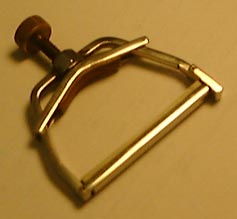 |
They were made of brass initially and this is the only yoke
capo where the protection plate is hinged on the side of the yoke. Later they were made of
stainless steel with a brass screw. The steel capos were slimmer. John Holman, USA, made these capos for about a year or two. They had to be fitted precisely to the individual instrument and they were sensitive to fret wear. That is probably why they didn't make it commercially. |
Capos of this type need some device to keep the protection plate from
turning around. For simpler
manufacturing, the plate itself can be used for the purpose:
| McKinney Designed by Thomas H McKinney III. An early McKinney capo, made from 1976 to 1985 when it was replaced by a new design (see below). Kyser made this type of capo out of aluminum for a while and called it ELITE. The yoke passes through notches at each end of the plate... |
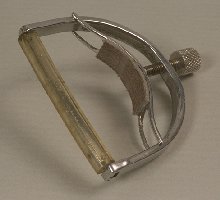 |
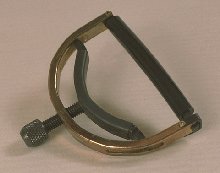 |
Paige ...and here the ends of the protection plate pass through slots in the yoke. US Patent 1992 by Bryan R Paige. |
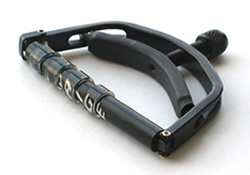 |
Paige has a clever solution for the 12-stringed guitar. Four small pieces of tubing takes care of the thin octave strings. |
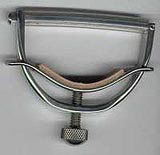 |
Elliott Here the yoke passes through oval holes in the protection plate. For quick installation and removal a spring-loaded button is installed in the end of the crossbar. The underside of this button is contoured to fit into a slot in the top end of the yoke. This capo is beautifully crafted and made of stainless steel. |
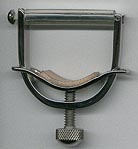 |
Designed and made by Phil Elliott, Elliott Capos, USA. |
 |
Kat Eyz The yoke and bar on this stainless steel capo is made from round stock. The neck protection plate is guided in grooves inside the yoke. This makes the plate more stable and the outside of the bar is kept smooth. The idea of the V-shape is to make the capo more stable due to two points of contact on the back of the neck rather than one. It also helps lining up the capo parallell to the fret and it protects the neck if the screw should wear through. Designed and marketed by Mike Smith, Kat Eyz, USA. |
Following developments all aim to prevent the screw from wearing through the
protection plate
and marring the back of the neck:
| Hamilton Screw Type | |
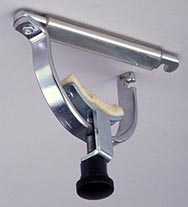 |
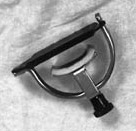 |
| The protection plate has an extension bent around the yoke to rest upon the thumbscrew. This unloads the protection plate from the pressure of the screw. | This one has a spring bar to adjust to curved
fretboards. No patent. Made by Hamilton Stands Inc, USA. |
| Hamilton Fretspanner | |
| This is an extreme capo. The very wide bar spans
over the frets, preventing the strings from being pressed down too far. It clamps the
strings against the frets instead of stretching them against the fretboard. Retuning is
eliminated and clamping force is minimized. It works effectively but was not a commercial
success because of its cumbersome size. The Fretspanner was designed around 1980 by
Wayne Clyburn, Kentucky, who donated one to the Capomuseum. |
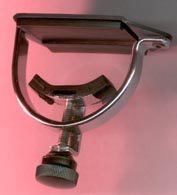 |
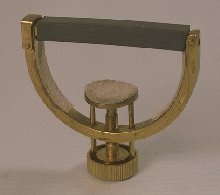 |
Golden Gate The two steering pins are extended all the way down to a groove in the head of the thumbscrew, giving support to the protection plate. Design 1981 by Terumi Nakamoto, Japan. |
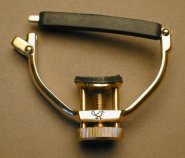 . |
Ptacek Here the two pins are fastened both in the protection plate and to a circular plate that rests on the head of the thumbscrew. This eliminates the need to fasten the screw in the plate. First rate craftsmanship. Made by Vladislav Ptacek, Czech Republic. |
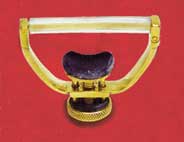 |
Dan Crary Capo Since about 1997 this capo is also marketed under another name. The only difference is the tubing. Same maker. Marketed by Thunderation. |
| McKinney A beautiful crafted capo made of stainless steel. The bent down plate extension passes through a small yoke on one side to rest upon the thumbscrew. US design 1985 by Thomas H McKinney III. When McKinney stopped making his capo, Daniel Smith made it for a couple of years.
Around 1993 production was continued by Bill Stokes. |
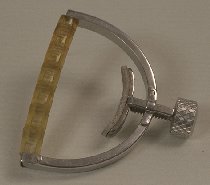 |
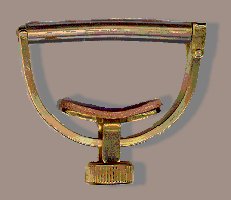 |
Ol' Reliable™
The support is further simplified to a pair of bent down extensions on opposite sides of the yoke. It is really a copy of the capo that the English inveterate tinkerer Henry Gustave Melville-Pearse made for his eight year old grandson, John. Made in US by John Pearse® Strings. |
Here is another way to prevent the screw from wearing through the neck protection:
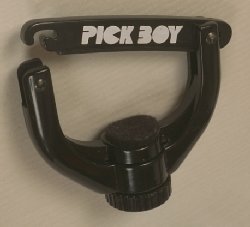 |
PickBoy Plastic capo. The screw is fastened upside-down in the neck protection, and the capo is tightened by turning a large nut seated in the yoke. Extensions from the neck protection runs in grooves inside the yoke. Note the locking slot at the end of the bar. Made by Nacano Co Ltd, Japan. |
| Here is a homemade capo. A Teflon cap on the end of the screw protects the
neck. The bar is a thin stainless steel tube covered with a silicon rubber varnish. The
locking stick is made out off a bicycle spoke and sticks through holes in the yoke and
through the bar. The inside of the yoke is covered with foam rubber. Made in 1987 by Iorgulescu Radu, Roumania. |
| This may also be a homemade capo, although
machined by a skilled craftsman. Note how the little springy clasp fits
over the end corner of the bar. Owned by Anthony Howell, USA. |
  |
The yoke capo can be simplified by using a nut instead of a screw.
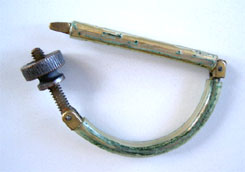 |
Sterner Prototype 1 I came up with this idea
for a capo in 1995. I made one for my own use and thought the idea of using a nut for
adjustment was very cool. 1) The yoke capo could be simplified. 2) The fastening means
were placed out of the way for the fretting hand. 3) The thread length inside the nut
would be much longer than in a threaded hole though the yoke. Worn out threads is a common
problem with yoke capos. 4) The capo could be snapped open and be removed very fast. |
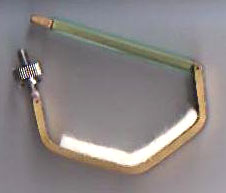 |
Koyama Tetsuo Koyama from Japan has came up with exactly the same idea! The only difference is the felt pad to protect the back of the neck and the shape of the yoke. Made by Kilalacrafts, Japan. |
|
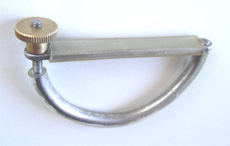 |
Sterner Prototype 2 Based on the nut idea, I
made this capo in 1996. The idea was to simplify it further by using as few parts as
possible. It has only three metal parts. The yoke is riveted in one end and the bar is
kept from sliding down by the plastic tubing around the yoke. The other end of the yoke is
threaded. This capo was intended to be kept permanently on the guitar neck and stored
above the nut when not in use. Later I found out that a capo like this was patented as
early as 1892 by Volkmar T Johnsen, USA. |